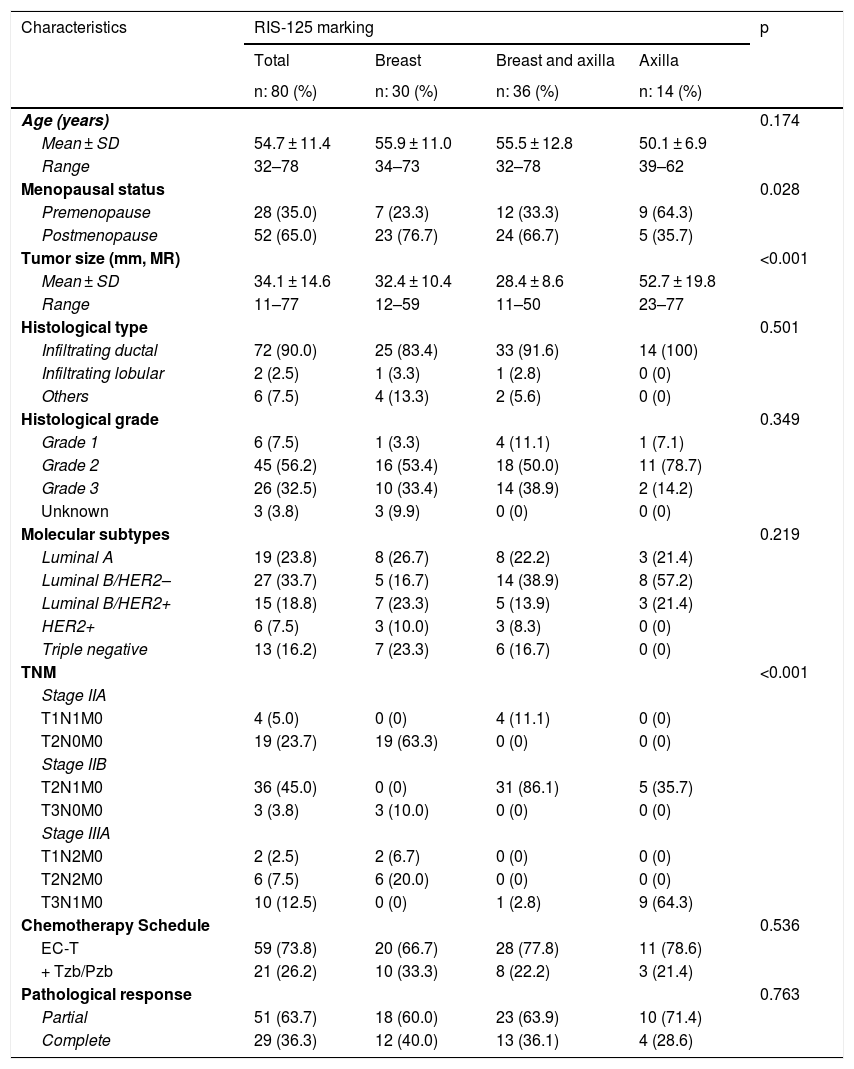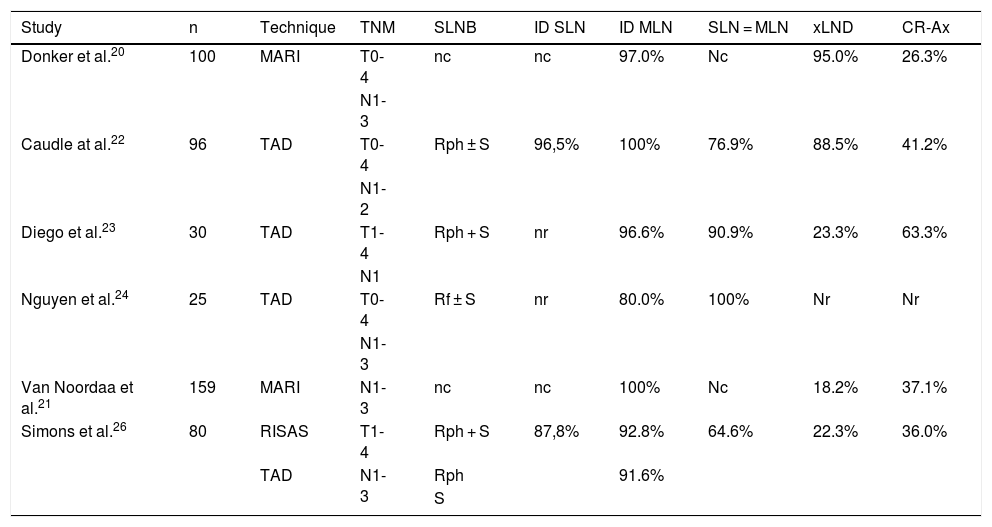To evaluate the use of radioactive iodine-125 seed (RIS) in breast and/or axillary surgery, in patients with breast cancer treated with neoadjuvant chemotherapy (NAC).
Material and methodsProspective study between January 2016 and June 2020. 80 women T1-3,N0-2,M0: 30 RIS marking the breast tumor, 36 both the tumor and the biopsied positive axillary node, and 14 only the axilla. Age: 54.7 ± 11.4 years. Tumor size: 34.1 ± 14.6 mm. Histological type: invasive ductal carcinoma 90.0%. Molecular subtypes: luminal-A 23.8%, luminal-B/HER2- 33.7%, luminal-B/HER2+ 18.8%, HER2+ 7.5%, basal-like 16,2%.
ResultsOf the 66 patients with RIS marking of the tumor (51 pre-NAC, 15 post-NAC), 92.1% had tumor-free surgical margins, with a specimen volume of 126.7 ± 111.2 cm3. Of the 5 s local excisions, in 3 the resection margin was involved (1 mastectomy).
Of the 50 patients N1 with RIS marking (MLN), 44 pre-NAC and 6 post-NAC, MLN was identified in 97.2%: negative 23, positive 26. In 45/50 patients, sentinel node biopsy (SNB) was performed and it was identified in 93.3%: negative 26, positive 16. In 1 case RIS was not placed correctly and SNB was not identified due to non-migration.
In 61.9% of the patients, MLN was among the SNB identified in the surgery. In 5 patients with mismatched SNB and MLN, the pathological result of the SNB was negative and the MLN was positive. Axillary lymph node dissection was performed in 53.8% of the patients.
ConclusionRIS allow to perform breast-conserving surgery and improve detection of residual axillary disease in patients treated with NAC.
Evaluar la utilización de las semillas radiactivas de yodo-125 (SRI-125) en la cirugía de mama o axila, en pacientes con cáncer de mama tratadas con quimioterapia neoadyuvante (QtNeo).
Material y métodosEstudio prospectivo, entre enero del 2016 y junio del 2020; 80 mujeres T1-3, N0-2, M0: 30 marcaje SRI-125 del tumor en mama, 36 tanto del tumor como del ganglio axilar positivo biopsiado, y 14 solo de axila. Edad: 54,7 ± 11,4 años. Tamaño tumoral: 34,1 ± 14,6 mm. Tipo histológico: ductal infiltrante 90,0%. Subtipos moleculares: luminal-A 23,8%; luminal-B/HER2- 33,7%; luminal-B/HER2+ 18,8%; HER2+ 7,5%; triple negativo 16,2%.
ResultadosDe las 66 pacientes con marcaje SRI-125 del tumor (51 pre-QtNeo, 15 post-QtNeo), el 92,1% presentaba márgenes quirúrgicos libres, con un volumen de las piezas de 126,7 ± 111,2 cm3. De las 5 reintervenciones, en 3 la ampliación fue positiva (una mastectomía).
De las 50 pacientes N1 con marcaje SRI-125 (GM), 44 pre-QtNeo y 6 post-QtNeo, se identificó el GM en el 97,2%: negativo en 23, positivo en 26. En 45 se realizó biopsia selectiva del ganglio centinela y se identificó en el 93,3%: negativo en 26, positivo en 16. En un caso la SRI-125 no se colocó correctamente y tampoco se localizó GC por no migración.
En el 61,9% de las pacientes el GM se encontraba entre el/los GC identificados en la cirugía. En 5 pacientes, con GC y GM no coincidentes, el resultado anatomopatológico del GC fue negativo y el GM positivo. En 53,8% de las pacientes se realizó linfadenectomía axilar.
ConclusiónLas SRI-125 permiten realizar cirugía conservadora de la mama y mejorar la detección de enfermedad residual axilar, en pacientes tratadas con QtNeo.
Artículo

Revista Española de Medicina Nuclear e Imagen Molecular (English Edition)
Comprando el artículo el PDF del mismo podrá ser descargado
Precio 19,34 €
Comprar ahora










